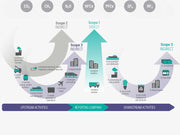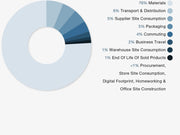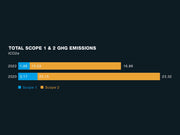Our Carbon Footprint
It’s an unavoidable fact that everything we make has an impact on the planet. No matter how much work we do to reduce that impact, what materials we source, or the partners we choose to work with, making any garment will inevitably create carbon emissions.

Breaking down Carbon Scopes. (Image courtesy of GHG Protocol)
From farms, to factories, all the way to Finisterre, every step through our supply chain requires resources and produces emissions. It’s our job to understand the full scope of this and to continue to implement measures to reduce our impact wherever we see the opportunity.When measuring the emissions produced by a business there are three ‘scopes’ that constitute different areas of activity to account for. So, what do these three different scopes measure?
Scope 1 – All Direct Emissions
This covers any emissions directly produced by an organisation – this can be from any company vehicles, or from other greenhouse gas (GHG)emissions produced by boilers and air-conditioning.
Scope 2 – Indirect Emissions
This covers the emissions resulting in the production of electricity that we use – that’s basically everything from keeping the lights on to heating, cooling and running the electronic devices we need to work on.
Scope 3 – All Other Indirect Emissions
This covers everything else. Yes, everything. Anything from our activities that we do not own or control. That’s the footprint of any materials we buy, the shipping of those materials, the manufacturing process that turns them into garments, the further shipping of the materials to be sold, even through to waste disposal.

We first measured our carbon footprint across our supply chain and business in 2020 (scope 1, 2 and 3 emissions). We were supported by Green Element, an environmental management consultancy and fellow B Corp.
They have over 20 years’ experience helping businesses to become more sustainable, creating tools like Compare Your Footprint to provide organisations with an easier way to calculate the carbon footprint of their operations.
Our early conversations centred around how much of our business we could feasibly obtain emissions for. Even before we started hunting down the data, we knew that a huge portion of the emissions we as a company are responsible for would fall into scope 3.
Did it take longer? Yes. Did we find some things we’d rather not have? Obviously. The uncomfortable truth is that we produce a considerable amount of carbon making our clothes. Most of our carbon emissions come from our supply chain – from materials, transport, manufacturing, and distribution. Armed with the baseline data we were able to set reduction targets.
Aligning with Science Based Targets
We have used our 2020 baseline carbon footprint to set near-term science-based targets that are aligned to the Paris Agreement’s 1.5ºC cap on global heating. These targets have been officially validated by the Science Based Targets Initiative (SBTi) through their streamlined route for small and medium-sized enterprises (SMEs). We are committed to reducing scope 1 and scope 2 emissions 42% by 2030 from our 2020 base year, and to measure and reduce our scope 3 emissions. Our aim is to also validate our long-term net-zero target.

Our 2022 Footprint
What we measured:

We were supported by Green Element, an environmental management consultancy and fellow B Corp, to calculate our 2022 carbon footprint. They have over 20 years’ experience and have created tools like Compare Your Footprint to provide organisations with an easier way to calculate the carbon footprint of their operations.
Since our baseline year we have extended the scope of our footprint to capture more of our scope 3 emissions, including homeworking, commuting and the end of life of sold products and packaging.
The results
Our total carbon footprint for 2022 was 3802 tonnes of CO2e.
92% of our GHG emissions are produced in the supply chain – materials, transport, manufacturing & packaging – which is covered by scope 3. 76% of those emissions come from the textiles themselves; from growing to processing and creating the fabrics.

*Market Based GHG Emissions *Our carbon emissions are reported one year in arrears because it takes time to gather quality data
Our carbon footprint has increased since 2020 and there has also been a shift in weighting in different categories. We anticipated this, but why and how has this happened?
Accuracy in data collection and reporting plays a significant role in the fluctuations of a business's carbon footprint. When we conducted our baseline assessment for 2020, a vast amount of the data we needed was not readily available. It was a huge learning experience. The impacts of the COVID pandemic also meant that our standard business operations completely changed, with stores and offices closed for prolonged periods. Although not ideal, this resulted in us having to rely on estimates to try and build up a picture of a ‘normal’ year’s carbon footprint.
For our 2022 footprint, we applied improved carbon emissions factors; a way of measuring the carbon emitted by one unit of a product or activity. As we expected, these updates resulted in higher emissions for certain activities. We have also extended the scope of our footprint by including more categories and activities within our value chain.
It's essential for businesses to stay informed about updates in carbon emission factors throughout their production chains and incorporate them into their carbon accounting practices, to ensure accurate measurement and reporting of their environmental impact.
Our business has also grown in the last few years, resulting in increased needs for energy consumption, transportation, and production outputs. This has also led to a temporary increase in carbon emissions before the implementation of more sustainable practices.
Furthermore, as supply chain transparency improves, we are gaining access to more accurate data regarding the environmental impact of different tiers of suppliers' activities. Achieving a more sustainable supply chain can take time and effort, but it is something we are committed to.

*tCO2e is tonnes of carbon dioxide equivalent greenhouse gas emissions, including the 7 Kyoto Protocol key GHG groups.
We have managed to successfully reduce our scope 1 & 2 emissions by 28%! We did this by switching the power for our stores and offices to renewable electricity, and at the end of 2022 only two of our sites were not being powered by 100% renewable energy. This was a major achievement. However, due to the energy crisis, some sites were unable to switch energy tariff as green energy providers stopped accepting new customers. By the end of 2023 we improved on this again and all except one site were powered by 100% renewable energy.
We are on track to achieve our scope 1 and 2 near term target by 2030.
We now need to focus on cutting these indirect emissions (scope 3) to reach our climate goals, investing resources to help streamline the process. This will give us meaningful data on our carbon hotspots, enabling us to build a realistic carbon reduction strategy to meet our science-based targets.
Find out more
Impact Report 2023














































